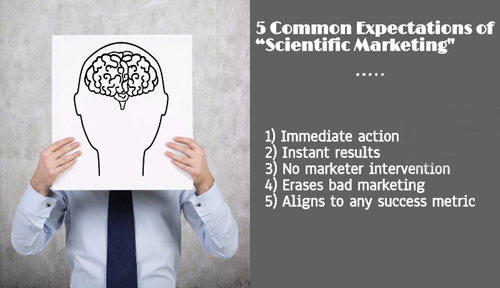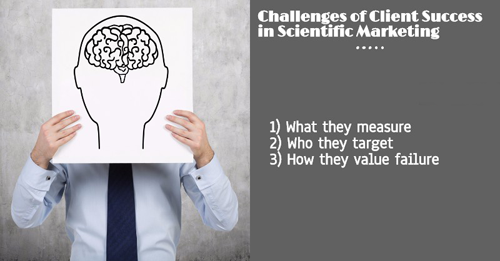A Closer Look at Scientific Marketing [Q&A with Amplero's Glenn Pingul]

In this era of artificial intelligence, there is tremendous opportunity for marketing to evolve and even transform. It's time for that change. Marketers know that the traditional, and highly manual, rules-based approach to running campaigns doesn't scale to achieve true personalization across millions of customers. So the question is - how can technologies like machine learning help?
We thought we'd ask an expert in the field, so Website Magazine recently sat down with Glenn Pingul, vice president of scientific marketing strategies at Amplero, a company squarely in the center of the machine learning marketing space.
Pingul shared his thoughts on the future of marketing enabled by science, why marketers should care about machine learning and key challenges companies face when deploying a machine learning marketing capability.
What is "machine learning"?
Machine learning is a type of artificial intelligence that allows systems to make decisions by identifying patterns that humans can't otherwise see. For marketing, machine learning is a technology enabler that allows for true 1:1 personalization at scale. Essentially, with machine learning, marketers can automatically decide the optimal experience for each customer in any given context across a customer base in the millions.
The difference between machine and human learning is that the machine can scale and measure thousands of permutations of the customer context to decide what is optimal, given a long-term business objective such as boosting revenues or increasing retention. In essence, marketers determine what key performance indicator (KPI) to drive and based on that objective, the system directly measures all elements of the customer context, executing the "right" personalized offer at the right time for each customer.
Importantly, machine learning "informs" the marketer how customers truly act including how they respond to current marketing efforts. This illumination into customer behavior enables marketers to be more creative and more targeted in their marketing efforts.
Why should marketers care about machine learning in 2016?
There are many marketers focused on how to optimize the lifetime value of their customers. At the same time, most of them are limited when it comes to being able to determine the optimal offer for each customer and context, in order to increase revenues, for example.
Without machine learning, it's virtually impossible for marketers to do much more than perform A/B testing of campaigns. Marketers don't have the resources to manually configure thousands of permutations (or mini campaigns) that machine learning capabilities can, let alone adjust those mini campaigns as results change. Machine learning is a game changer for marketers because it helps them experiment, learn and make decisions at a pace and scale that's not humanly possible. As a result, marketers get better results, sustain results and most importantly, know the "why" behind those results.
When companies talk about having a "scientific marketing" capability what do they really mean? Why does this matter?
Most companies refer to scientific marketing as behavioral monitoring or trigger-based predictive analytics. Collaborative filtering is the polar opposite of scientific marketing. It's saying if a customer did A, they will do B based on the behavioral insights gleaned from other similar customers, as opposed to making a recommendation based on the specific behavior of that customer. This is key because marketers are still guessing when it comes to which targeting rules drive high performance, and they don't test efficiency at layers below broad segment application.
What marketers need to remember is that understanding customer behavior is only half the equation. You have to have a way to decide what experience to deliver to an individual customer based on insights into their unique customer behavior, not that of a broad segment.
What are some common expectations of "scientific marketing?

When it comes to how a machine learning marketing platform like Amplero actually works, people's expectations are often far from reality. A lot of people think:
1) That the system knows what to do right out of the gate. In reality, machine learning needs to test and collect data on customers to assess if a pattern is real or an anomaly. It also needs input from marketers to run tests in order to learn what works and doesn't.
2) That the system starts getting results instantly. You won't get results the first day, but you can start getting feedback in just a few weeks. Amplero needs time to test and learn from a wide range of marketing treatments. If you're measuring 14-day revenue or 90-day retention, you will need to wait that long to see results.
3) That the system does marketing for you as opposed to being an enabler. Deploying a scientific marketing capability does not mean that companies can get rid of half of their marketing department. Marketers play a critical role - more so though for their creative and strategic thinking versus operational tasks such as creating target lists and performing analysis.
4) That the system will make up for bad marketing (e.g. campaigns that heavily discount a product just to drive adoption). Bad marketing can't be fixed by machine learning. The old adage, "garbage in, garbage out" definitely applies here. If you feed bad marketing messages or promotions into a machine learning platform, it will optimize the performance of those messages but, in this example, by minimizing loss rather than achieving incremental gain.
5) That the system will align to any success metric. In the case of Amplero, the system measures longer term effect. Most marketers tend to focus on short-term metrics such as take rates or clicks, and assume a correlation to long term metrics like topline revenue. With Amplero we discount those early, and often false, metrics and focus on KPIs that show true incremental revenue lift (even beyond just topline revenue).
What's the most difficult thing to change about what your clients do to help ensure their success?

There are three big things. The first is what they measure. Marketers often rely on short-term metrics such as click-through rates or take rates because they are easier, simpler and faster to report. However, these early indicators may or may not have any correlation to what really matters, like long-term revenue. The challenge is changing the perception of when and how to measure campaigns so that the marketer thinks about what drives long-term KPIs vs. responsive elements of the campaign itself.
The second is the effort spent on who to target for a certain proposition. Segmentation introduces bias right out of the gate. This is because segmentation relies on assumptions and intuition about what offers are best for whom, and because the focus is on trying to reach the highest response rate against a targeted group. As a result, pockets of opportunity, such as customer types based on other behavioral attributes, representing potential lift are missed.
The third is valuing what doesn't work in campaigns. Marketers need to see what isn't working because the machine will continue to test and adapt based on the learning. Key to optimization are the learnings that come from failed campaigns (e.g. those that have a negative impact on performance lift).
What advice would you give marketers to prep for the science-enabled future of marketing?
What's key is getting marketers to trust the machine to manage the experimentation and optimize results. Incorporating machine learning that is constantly optimizing and accounting for all factors of the customer experience is the only way to evaluate and measure campaign success in a scalable way. The science-enabled future of marketing will still require critical thinking around what to measure and continue to optimize. The marketer is still at the center of the process, but they are focused more on strategy and creation rather than reporting and campaign setup.
It's essential to note that the machine doesn't take over for the marketer. It will provide quantitative insights to the marketer on a massive scale and present an opportunity to spend resources on what to test and optimize. This introduces a new way of thinking regarding campaign management: thinking about it in a closed loop process as opposed to a linear process. Most campaigns today are thought of as start to finish instead of continued exploration and learning applied to real-time decision-making.
Why aren't more marketers engaging in the practice? Is it not right for every enterprise?
For one, not all marketers are the same. Some companies in specific industries have more of a need for quantitative marketing than others. Companies in the digital space like Amazon are a good example. Companies that already collect lots of individualized behavioral data are a step ahead and will pave the way for more traditional companies as they aim to monetize their data to more effectively compete.
There's also the fact that a shift to more sophisticated marketing requires technology and change. The traditional process for running campaigns is cumbersome but known. New technology that enables a different, machine-automated approach to marketing must be embraced, and marketers have to be ready for that sort of change. Marketers realize the benefits of machine learning in achieving superior customer experience and better performance results, but that doesn't mean everyone is an early adopter of the technology.

Subscribe to Our Newsletter!
Latest in Software






![A Closer Look at Scientific Marketing [Q&A with Amplero's Glenn Pingul]](https://www.websitemagazine.com/hubfs/Imported_Blog_Media/scientific-mind_100x100-3-1-1-1.png)

